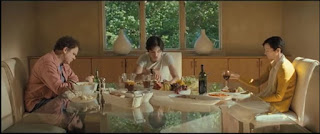Week 9: Editing | West Side Story: Movement and Space
When trying to think of a sensory experience I've had that was enhanced by editing, I spent a long time looking at fight sequences, or sequences involving physical violence. However, after reading Karen Pearlman's article, I started to think more about how dance on screen provokes, at least in me, a unique feeling of satisfaction to see bodies move so perfectly in time with music.
West Side Story (Jerome Robbins, Robert Wise, 1961) won the Academy Award for Best Editing in 1961 and I think its opening prologue is the best illustration of why. Without any dialogue (or singing), its opening ten minutes is a essentially a dance sequence that sets up the whole conflict for the film. Simply by observing their movements, we come to understand the rivalry between the Jets and the Sharks, and how it spans across an entire neighbourhood in New York.
At the beginning of the sequence, we are introduced to the Jets, and their dominion over their space. Their movements push their bodies to take up as much space as possible, reaching their arms upwards and their legs outwards. They move elegantly, and swiftly across the space, and the cuts that perfectly match the action between the shots allows them to move quickly between different locations in the neighbourhood whilst maintaining the smoothness of their movements. One cut that is particularly satisfying takes them from the pavement in one street, and by stretching their arms up into the air, a ball falls into their hands and we cut to a playground where they're playing basketball. All of this contributes to the group persona of the Jets as the more confident gang that are at home in their city.
Pearlman talks about the possibility for editing to shape physical energy in order to convey a narrative, and the combined exaggeration of their gestures with the way they effortlessly move across the space works to establish the Jets as the dominant group. Pearlman also talks about how cinema (and editing in particular) can offer so much more to a dance choreography than just filming it and showing it in its entirety. By 'dancing the edit', the edit point becomes an 'expressive element of the physical action.'
In the last few minutes of the prologue, the conflict escalates between the two groups, and whilst they're still dancing and performing in this way, the edit contributes far more the the pacing of the action and conveys the chaos that the rivalry is bringing to their neighbourhood. The cuts no longer emphasise the smoothness of the movements but show people running in opposite directions between different shots. Between shots where the action is more static, or seems to be moving away from the general chaos of chasing and being chased, there are cut in swish-pans that keep up the pace of the conflict, whilst also conveying how far across the space the groups are moving, and how the action is sprawling across the city.
A final note on the music, because the action of this sequence is also set to music, the editing has had to take this into consideration. At many points the cuts are in time with elements of the soundtrack, for example at the very start as the Jets are clicking their fingers, the cuts are in time with this sound effect. Again, this contributes to the flow of the movements and brings together the sound, and visuals for a seamless transition into the genre of the musical.


Comments
Post a Comment